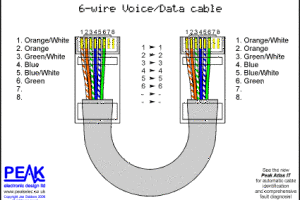Structured Cabling Downtime Reasons
by William B. Buckingham, RCDD
[hozbreak]
The Information Transport System (ITS) is the nerve system of all business or organizations and deserves the highest level of attention during new construction, major upgrades and/or expansions. In the past, the Technology and Communications Industry was not effectively included in Division 16 of the CSI MasterFormat. Often there was no space allocated in the building, or money in the budget, for the technology infrastructure requirements. In many projects it is typically after construction has started that it becomes obvious that technology had not been adequately addressed. These “new” technology requirements resulted in design changes and change orders to the contract.
Today’s technology is changing at a pace that even 10 years ago was unthinkable. The Building Industry Consulting Services International (BICSI) is a professional association supporting the information transport system (ITS) industry. The information transport system covers the spectrum of voice, data, electronic safety & security, and audio & video technologies. It encompasses the design, integration and installation of pathways, spaces, fiber and copper cable based distribution systems, wireless-based systems and infrastructure that supports the transportation of information and associated signaling between and among communications and information gathering devices. It wasn’t long ago that network managers were wondering if 10 gigabit Ethernet transmission would have any practical application in enterprise networks. Today it is standard. Communications Infrastructure Design, Planning and Implementation Management require a specialized technical expertise to integrate technology solutions into the workplace. The new MasterFormat 2004 has implemented a strategic plan for Communications, Life Safety and Building Automation (CLA) Systems. In prior versions of the MasterFormat, Division 16 – Electrical did not adequately address the evolving requirements of CLA. MasterFormat 2004 has now addressed those requirements. The new MasterFormat 2004 contains an effective and comprehensive model that can be used to better plan, build and also manage technology infrastructures. The following CLA divisions have a lot in common and require the most coordination with the new Division 26 – Electrical.
- Division 25 – Integrated Automation and Control (A)
- Division 27 – Communications (C)
- Division 28 – Electronic Life-safety (L)
The coordination for the placement of conduit and other pathway infrastructure is now more critical than ever.
The goal of a structured cabling system design is to allow the cabling investment to correspond more closely to the building’s designed life cycle and to provide the foundation for the client’s telecommunication standards and work practices.
The structured cabling infrastructure is the common thread for Communications Cable Plant, Data Systems, Voice Systems, Communication Services, Integrated Audio Video Systems, Distributed Communication Systems, Intercom Systems, Dictation Equipment, Paging Systems, Public Address, Other Audio systems, Sound Masking, Electronic/Digital Signage Systems, Tracking Systems, Video Systems – MATV, CATV and CCTV, Internal Cellular, Internal paging, Healthcare Systems, Nurse Call, Hospitality and Entertainment Systems, Clock Systems, Access Control, Electronic Surveillance Systems, Intrusion Detection Systems, Detection and Alarm, Personal Protection Systems, Integrated Automation Instrumentation and Control.
[hozbreak]
Significance of CLA and the role of the CLA Consultant
Significance of CLA
- Consider MEP – Mechanical Electrical and Plumbing
- Impact on Building in the late 1800’s and Early 1900’s
- New Spaces and Pathways “above the ceiling”
- New Consultants and Contractors
- New Standards and Codes
- Compare to CLA – Communications, Life Safety and Automation
- Impact on Building in the late 1900’s and Early 2000’s
- New Spaces and Pathways “above the ceiling”
- New Consultants and Contractors
- New Standards and Codes
- Realization
- MEP systems transport “energy”.
- CLA systems transport “information”
Need for a CLA Consultant
- The role of the CLA consultant should:
- Extend from master planning as a Strategic Consultant
- Extend through design and construction as a Project Consultant
- Extend into commissioning and operation as a System Consultant
- Ideally, the Owner’s Relationship with a CLA consultant:
- Begins well before the construction project begins with the consultant learning about
the owners requirements for systems and objectives - It is with this broad based understanding of the owner’s needs that a CLA consultant
can effectively design these needs into a building project
- Begins well before the construction project begins with the consultant learning about
[hozbreak]
Now the building Owners and IT Managers are requesting that the infrastructure for Communications and Technology be a totally integrated part of the construction drawings so that they don’t have to deal with a substandard communications infrastructure in a brand new building. Therefore, consideration should be given to the contract and obligations of the CLA consultant. If the architect and the client are both aware of the importance of this infrastructure then why not include the cost of the communications consultant for the design team from master planning through commissioning.
The CLA consultant on the design team should be a Registered Communications Distribution Designer (RCDD). The RCDD is the Building Industry Consulting Services International (BICSI) designation for individuals who demonstrate expertise in the design, integration, and implementation of telecommunications (data, voice, audiovideo and other low-voltage control) transport systems and their related infrastructure components. The RCDD designation is globally recognized within the industry.
Closing Thoughts
Because the computer network, telephone system and the safety of the employees, customers, patients and students are of highest importance to building owners, employers and administrators, we can not afford to treat this infrastructure as an afterthought or of low importance in the design of the building. Considering that current statistics reveal about 70 percent of network downtime is due to cabling problems, the danger of ignoring this vital element is severe.
Good telecommunications infrastructure design, standards and specifications at a minimum will give the building owner the ability to:
- Lower construction cost by minimizing change order requests.
- Improve the total quality of installations.
- Provide Technology/Communications infrastructures that are designed for the total Life-cycle of the
facilities which allows them to be adapted to meet the future requirements.
The Challenge…
Installing sufficient capacity to meet initial and long term requirements for space, power and cooling services is a challenge. In particular, many buildings will need much higher levels of electrical power and cooling in the future than when they were built.
The solution…
The solution to the problem of balancing cost and premature obsolescence is for the design team to distinguish clearly between initial requirements and the capacity, built into the infrastructure, to meet future requirements.
It has been said that the design team cannot attempt to design a building that meets all requirements, but rather one that can be adapted to meet them all. This adaptability is reflected in the design and sizing of spaces, services and infrastructure. The CLA Consultant is a key part of the design team.
 |
William B. Buckingham, is a Registered Communications Distribution Designer (RCDD). Over 24 years of knowledge and experience in the telecommunications industry, with a broad background in cable plant design, project management and installation. William B. Buckingham, RCDD bbuckingham@internet49.com (916) 616-9598 |




